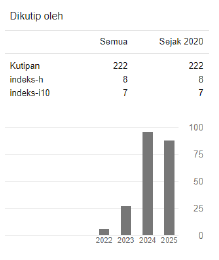The Effectiveness of Using Paired Storytelling Technique Towards the Students’ Reading Comprehension
 https://doi.org/10.54012/ijcer.v1i1.65
https://doi.org/10.54012/ijcer.v1i1.65
 Abstract views: 379
Abstract views: 379
 PDF downloads: 342
PDF downloads: 342
Keywords:
Teaching Technique, Reading Comprehension, Paired Storytelling, Students Skill, Efffective LearningAbstract
This research aimed to find out whether: (1) the paired storytelling technique is more effective than the conventional technique to teach reading; (2) the average score of students’ reading comprehension who learn reading through the paired storytelling technique is higher than those who learn reading through the conventional technique. The population was the second semester students of SMA Muhammadiyah Prambanan which consist of 77 students. Purposive sampling was used to determine the experimental class and control class. Each class consists of 26 students. The experimental class was treated by using paired storytelling technique, while control class was treated by using conventional technique. Then, the technique which was used to collect the data were multiple choice test for getting the data of students’ reading skill. The instrument of reading test was tried out to get the validity and reliability items. The data from post test were tested their normality and homogeneity. It was found out that the data were normal distribution and homogeneous. After that the data were analyzed to get the hyphothesis test by using ANCOVA.
Downloads
References
U. Flick, The SAGE handbook of qualitative data analysis. United States: SAGE Publication, 2014.
S. Cavallotti et al., “Dream content and intrusive thoughts in Obsessive-Compulsive Disorder,” Psychiatry Res., vol. 244, pp. 410–414, 2016, doi: 10.1016/j.psychres.2016.08.008.
I. Conference and T. The, “The 2 nd International Conference on Language , Literature , and Teaching.”
S. A. Vong and W. Kaewurai, “Instructional model development to enhance critical thinking and critical thinking teaching ability of trainee students at regional teaching training center in Takeo province, Cambodia,” Kasetsart J. Soc. Sci., vol. 38, no. 1, pp. 88–95, 2017, doi: 10.1016/j.kjss.2016.05.002.
Ş. Yaylacı and E. Beauvais, “The Role of Social Group Membership on Classroom Participation,” PS Polit. Sci. Polit., vol. 50, no. 02, pp. 559–564, 2017, doi: 10.1017/S104909651600319X.
J. Bielak, M. Pawlak, and A. Mystkowska-Wiertelak, “Teaching the English active and passive voice with the help of cognitive grammar: An empirical study,” Stud. Second Lang. Learn. Teach., vol. 3, no. 4, p. 581, 2013, doi: 10.14746/ssllt.2013.3.4.7.
K. Parry, “Culture, Literacy, and L2 Reading,” TESOL Q., vol. 30, no. 4, p. 665, 1996, doi: 10.2307/3587929.
B. Cambourne, “How Important Is Theory to the Reading Teacher?,” Aust. J. Read., vol. 2, no. 2, pp. 78–90, 1979.
W. Grabe and F. L. Stoller, Teaching and researching reading. Abingdon: Routledge, 2019.
I. K. Sagita, “Applying Conversation Method and Self-Confidence and Its Effect to Learning Achievement,” J. Corner Educ. Linguist. Lit., vol. 1, no. 2, pp. 122–131, 2021, doi: 10.54012/jcell.v1i2.11.
A. Jaya, H. Hermansyah, and E. Rosmiyati, “The implementation of project-based learning in increasing speaking achievement and self-confidence,” Indones. Educ. Adm. Leadersh. J., vol. 1, no. 1, pp. 4–19, 2019.
I. K. Sagita, “Applying Conversation Method and Self-Confidence and Its Effect to Learning Achievement,” J. Corner Educ. Linguist. Lit., vol. 1, no. 2, pp. 122–131, 2021, doi: 10.54012/jcell.v1i2.11.
Y. Nie, Y. Jia, S. Li, X. Zhu, A. Li, and B. Zhou, “Identifying users across social networks based on dynamic core interests,” Neurocomputing, vol. 210, pp. 107–115, 2016, doi: 10.1016/j.neucom.2015.10.147.
Mcael, “Teaching the Four Skills,” Teach. Toolkit, 2003.
J. A. Lander and H. D. Brown, “Teaching by Principles: An Interactive Approach to Language Pedagogy,” Language (Baltim)., vol. 71, no. 4, p. 843, 1995, doi: 10.2307/415773.
J. Harmer, “The Practice of English Language Teaching, 3rd Edition by Jeremy Harmer (z-lib.org).pdf.” 2001.
J. Harmer, The practice of English language teaching, 4th ed. Harlow: Pearson Longman, 2007.
V. Destika, “Effectiveness of Match Technique to Improve Students’ Vocabulary Mastery based on Gender,” J. Corner Educ. Linguist. Lit., vol. 1, no. 3, pp. 168–175, 2022, doi: 10.54012/jcell.v1i3.33.
K. C. McLean, M. Pasupathi, and J. L. Pals, “Selves creating stories creating Selves: A process model of self-development,” Personal. Soc. Psychol. Rev., vol. 11, no. 3, pp. 262–278, 2007, doi: 10.1177/1088868307301034.
N. A. Solikhah and R. A. Sari, “Influence of Summarizing Short Stories Towards Students’ Narrative Writing Ability,” J. Corner Educ. Linguist. Lit., vol. 1, no. 3, pp. 176–190, 2022, doi: 10.54012/jcell.v1i3.34.
G. J. Sitohang, A. Sumiati, and S. Susanti, “Effect of Problem Based Instruction Model Based on Learning Video and Educational Games Media on the Self Efficacy of Students of Class X SMK N 17 Jakarta,” J. Corner Educ. Linguist. Lit., vol. 1, no. 2, pp. 106–113, 2021, doi: 10.54012/jcell.v1i2.9.
G. J. Sitohang, A. Sumiati, and S. Susanti, “Effect of Problem Based Instruction Model Based on Learning Video and Educational Games Media on the Self Efficacy of Students of Class X SMK N 17 Jakarta,” J. Corner Educ. Linguist. Lit., vol. 1, no. 2, pp. 106–113, 2021, doi: 10.54012/jcell.v1i2.9.
Downloads
Published
How to Cite
Issue
Section
License
Copyright (c) 2022 Dewi Yohana Puspita

This work is licensed under a Creative Commons Attribution-ShareAlike 4.0 International License.









